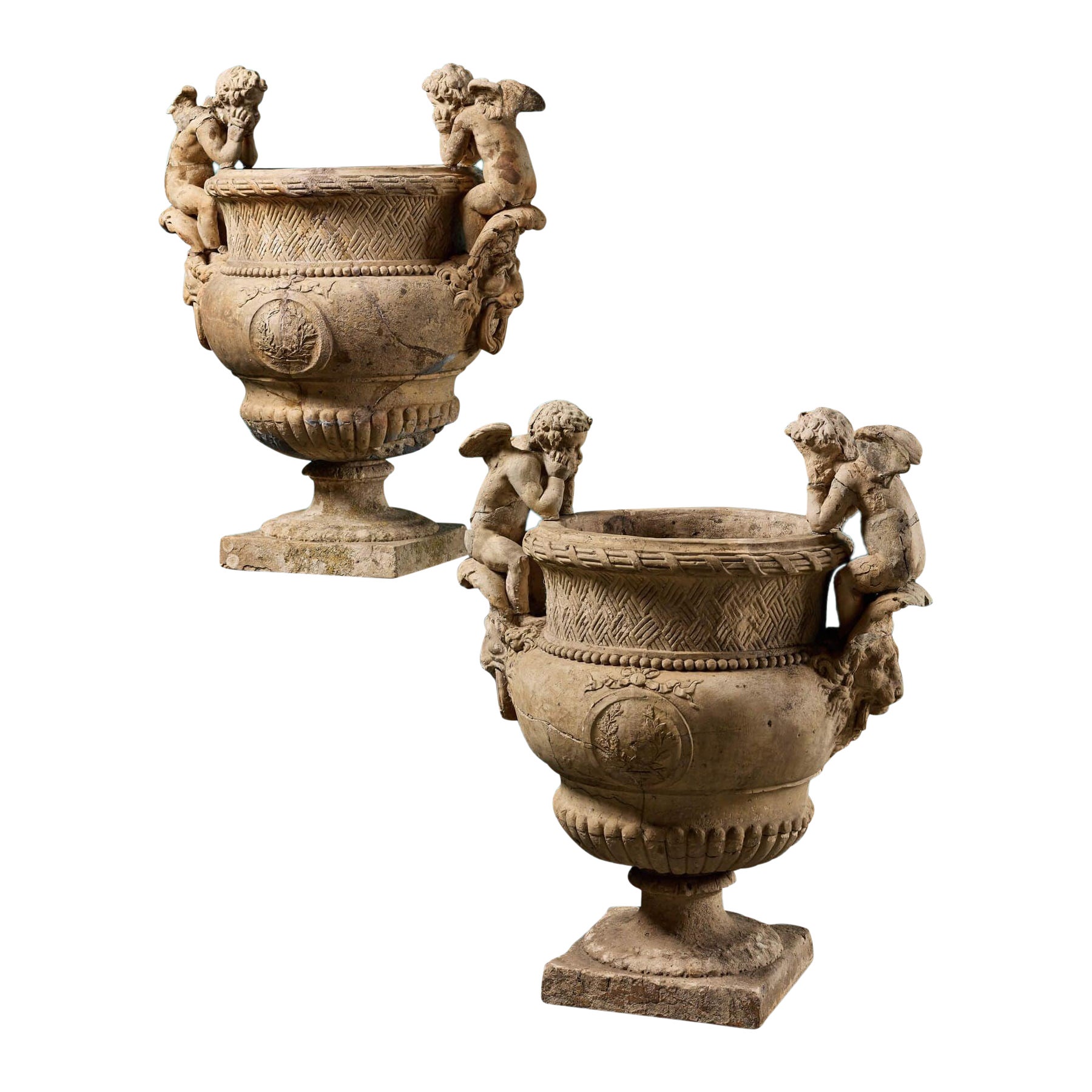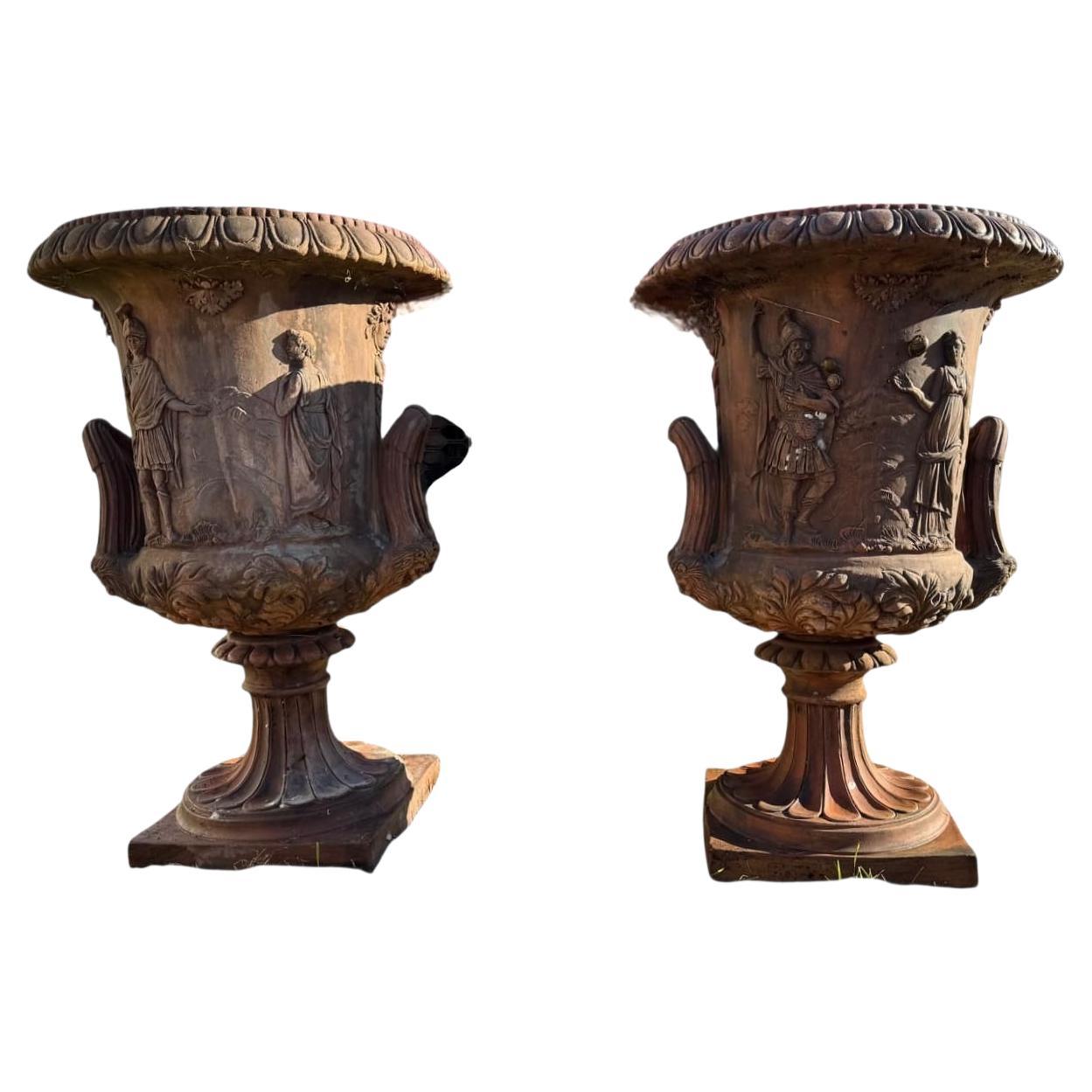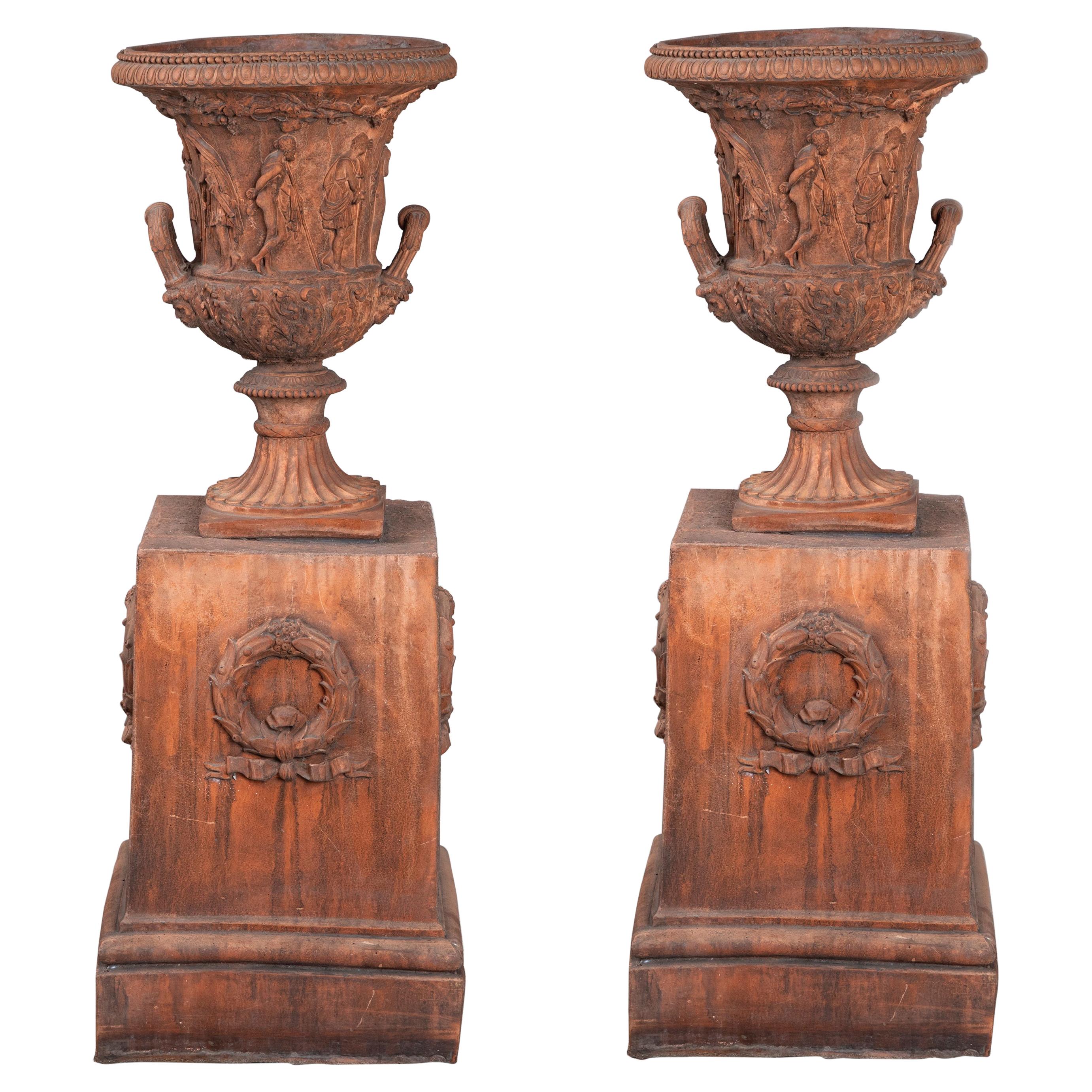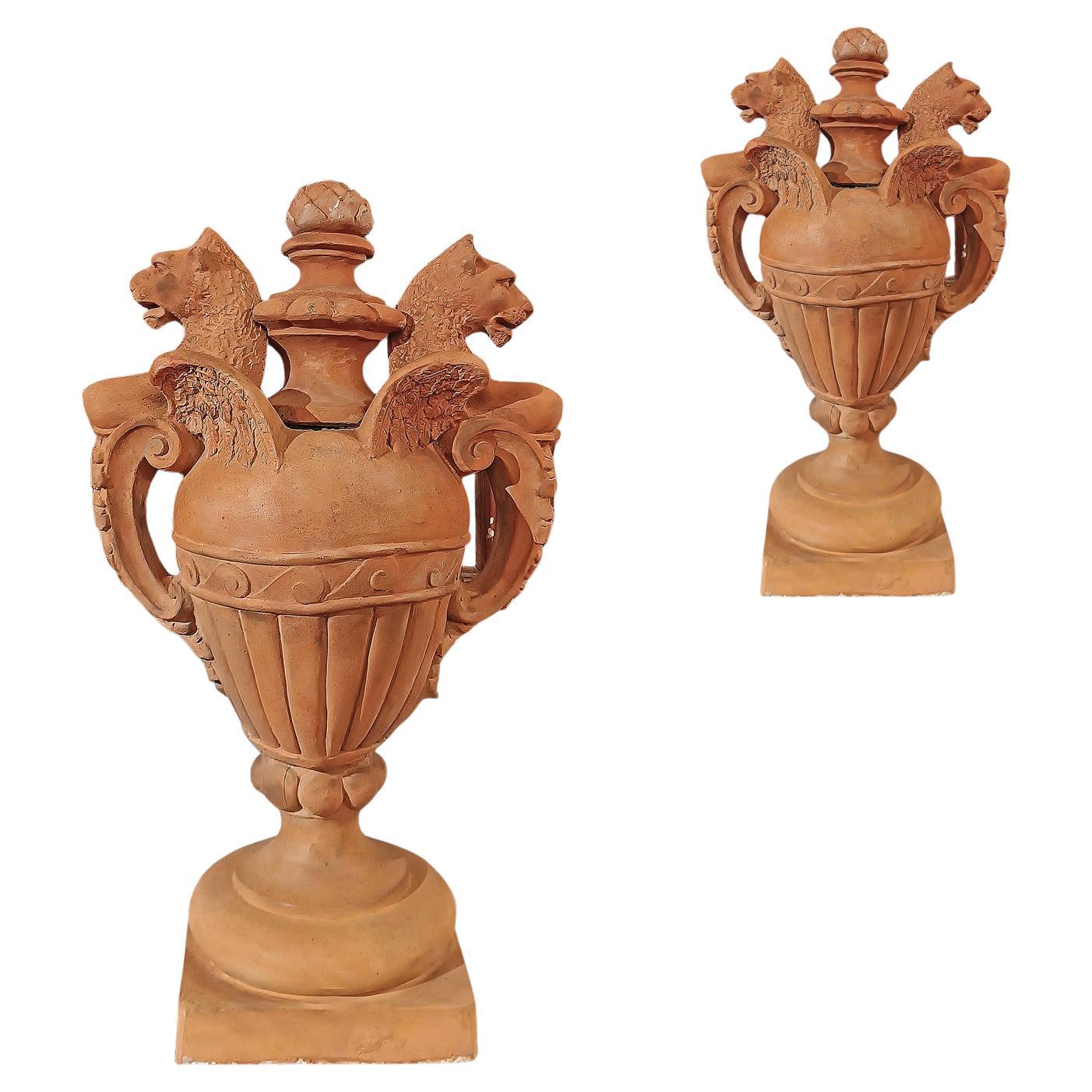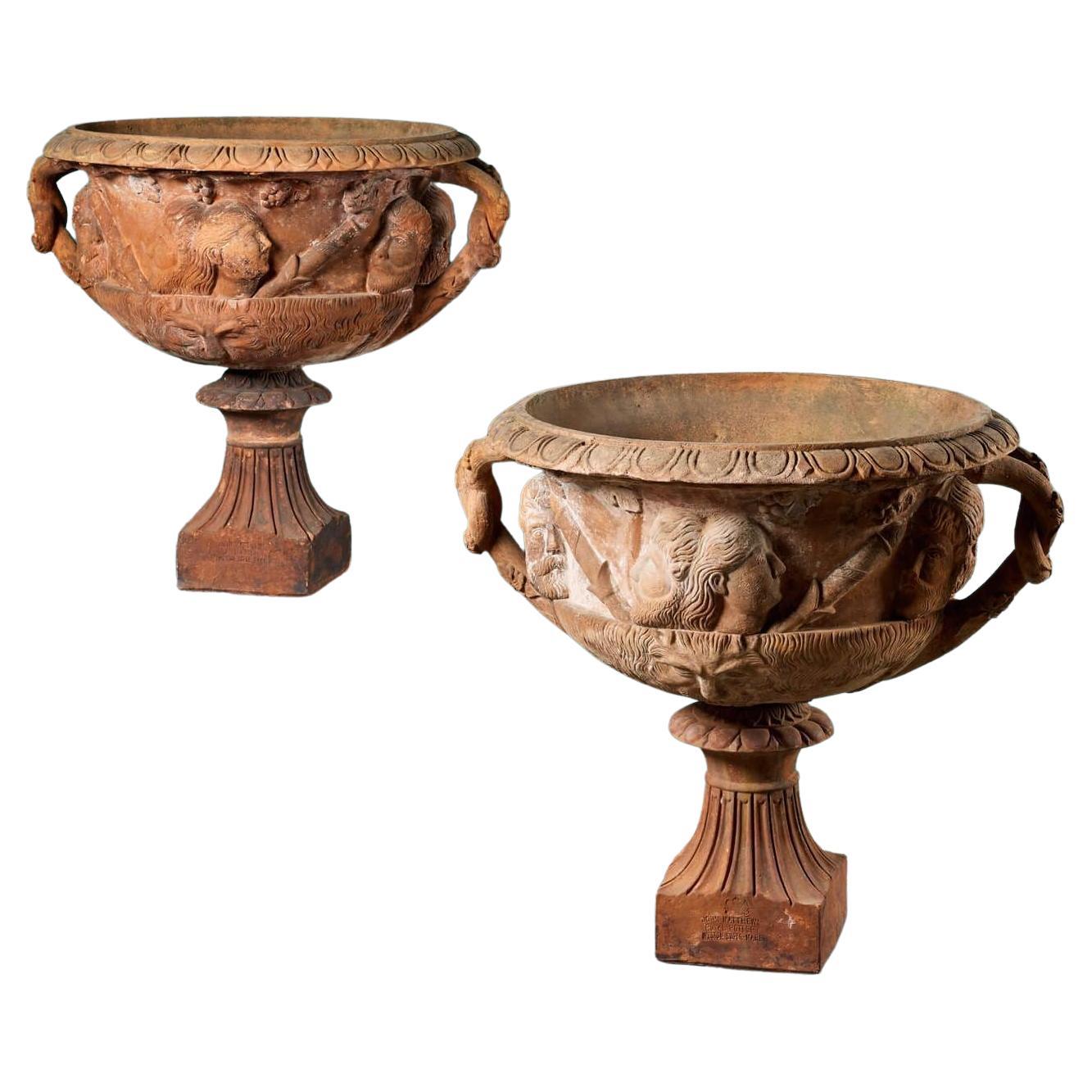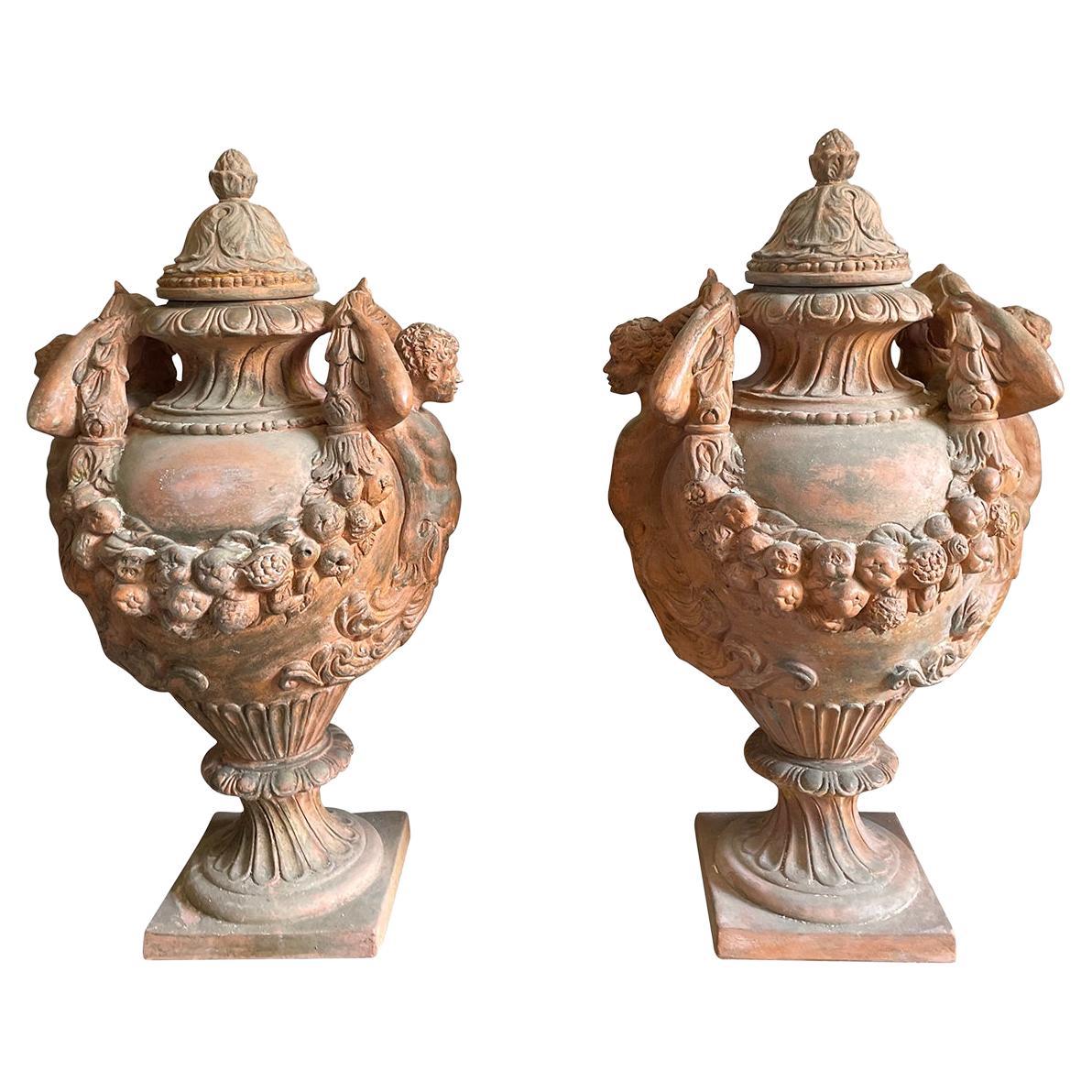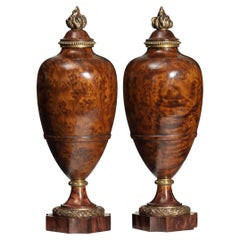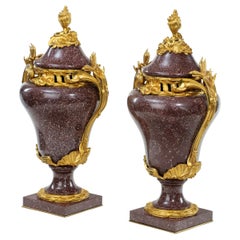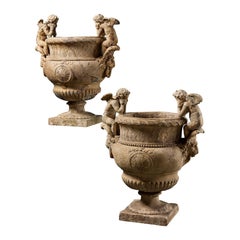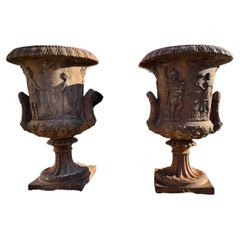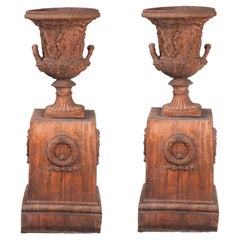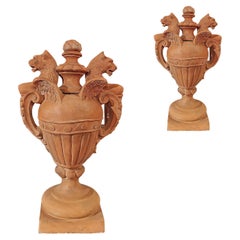Items Similar to A Pair of Davenport Admiral Lord Nelson Terracotta Wine Coolers
Want more images or videos?
Request additional images or videos from the seller
1 of 9
A Pair of Davenport Admiral Lord Nelson Terracotta Wine Coolers
$17,496.96
£12,750
€14,991.32
CA$24,158.49
A$26,789.98
CHF 14,076.15
MX$327,328.01
NOK 176,111.80
SEK 165,311.01
DKK 111,913.18
About the Item
A Pair of Davenport Admiral Lord Nelson Terracotta Wine Coolers, each relief moulded with a portrait of Admiral Viscount Nelson, in full uniform and medals, between two acorn-bearing oak boughs on one side and a naval panoply on the reverse. The rim comprises tied reeds with twin dolphin-mask handles attached to the sides. English, circa 1815.
Two very similar examples from the collection of Horatio, third Lord Nelson, are illustrated in an article titled ‘Nelson Relics and Relic Hunters’ in The Windsor Magazine, Vol. XX. June-November 1904, p.519. (See also page 4.) A thirdwith a paper label stating ‘Exceedingly rare (Lockett)’ was exhibited at the Hanley Museum, item No.1721 (see Britain on the High Seas, from Nelson to Churchill, p.71, Wick Antiques, 2019).
John Davenport (1765-1848) trained as a potter with Thomas Wolfe of Stoke, Staffordshire in 1785. By 1794 he had founded his own pottery factory counting the Prince of Wales among his customers. After Davenport’s retirement in 1830, his firm carried on under various family members until it was acquired by Burleigh Pottery in 1887.
- Dimensions:Height: 10 in (25.4 cm)Width: 11 in (27.94 cm)Depth: 11 in (27.94 cm)
- Materials and Techniques:Terracotta
- Place of Origin:
- Period:
- Date of Manufacture:Circa 1815
- Condition:Wear consistent with age and use.
- Seller Location:Lymington, GB
- Reference Number:1stDibs: LU973040032002
About the Seller
5.0
Recognized Seller
These prestigious sellers are industry leaders and represent the highest echelon for item quality and design.
Gold Seller
Premium sellers maintaining a 4.3+ rating and 24-hour response times
Established in 1982
1stDibs seller since 2013
133 sales on 1stDibs
Typical response time: 2 hours
Associations
LAPADA - The Association of Arts & Antiques Dealers
- ShippingRetrieving quote...Shipping from: Lymington, United Kingdom
- Return Policy
Authenticity Guarantee
In the unlikely event there’s an issue with an item’s authenticity, contact us within 1 year for a full refund. DetailsMoney-Back Guarantee
If your item is not as described, is damaged in transit, or does not arrive, contact us within 7 days for a full refund. Details24-Hour Cancellation
You have a 24-hour grace period in which to reconsider your purchase, with no questions asked.Vetted Professional Sellers
Our world-class sellers must adhere to strict standards for service and quality, maintaining the integrity of our listings.Price-Match Guarantee
If you find that a seller listed the same item for a lower price elsewhere, we’ll match it.Trusted Global Delivery
Our best-in-class carrier network provides specialized shipping options worldwide, including custom delivery.More From This Seller
View AllPair of Napoleon III Moroccan Burr Thoya Wood Urns
Located in Lymington, Hampshire
A pair of Napoleon III Moroccan burr thoya wood urns, turned from the solid, each in the form of a slender urn and cover on a shaped base, with an ormolu flame finial, beading and la...
Category
Antique 1850s French Napoleon III Urns
Materials
Wood
Pair Napoleon III Egyptian Imperial Porphyry Urns and Covers
Located in Lymington, Hampshire
A pair Napoleon III Egyptian imperial porphyry urns and covers, each with a shaped cover and baluster body on a concave support and square b...
Category
Antique 1870s French Egyptian Urns
Materials
Ormolu
Pair of Large Meiji Period Bronze Vases
Located in Lymington, Hampshire
A pair of large Meiji period bronze vases, each of baluster form raised on three oni-mask feet on a ring-shaped base, applied with arched mask-and-ring handles, finely inlaid in patinated metals, silver and gilt with boys playing around a large water jar...
Category
Vintage 1910s Japanese Meiji Vases
Materials
Bronze
$33,964 / set
Fine Pair of George III Mahogany Wine Cisterns Attributed to Gillows
By Gillows of Lancaster & London
Located in Lymington, Hampshire
Each cistern is in the form of a fluted vase on a rectangular pedestal. The lead-lined vases have brass handles, removable lids with pineapple finials and taps. The crossbanded pedestals have cupboard doors enclosing slatted shelves for warming plates in one and a lead-lined slops drawers, a tambour fronted shelf and a cellaret in the other.
Susan Stuart, 'Gillow of Lancaster and London', 2008 vol 1 p308-315 illustrates many pedestal urns including the drawings for Workington Hall, Cumbria, dated 1788. PLates 342 and 343 show pedestals with a similar arrangement of shelves and drawers. Thomas Sheraton explained the functions of dining room pedestals in his 'Drawing Book' of 1793: 'IN spacious dining rooms the sideboards are often made without drawers of any sort, having simply a rail, a little ornament...
Category
Antique 19th Century English George III Obelisks
Materials
Mahogany
A Fine Pair of Bronze Urns or Vases and Covers c.1870
Located in Lymington, Hampshire
A Fine Pair of Bronze Urns or Vases and Covers After a Design Believed to Have Been Made By the French Animalier Auguste Nicolas Cain c.1870
The urns each on a shaped black marble s...
Category
Antique 1880s Italian Vases
Materials
Bronze
A pair of carved walnut mediaeval knights
Located in Lymington, Hampshire
A pair of carved walnut mediaeval knights, each wearing full armour with a visored helmet metal, breastplate and holding a lance, standing on a later pyra...
Category
Antique 1880s European Figurative Sculptures
Materials
Walnut
$54,549 / set
You May Also Like
Pair of 19th Century French Terracotta Urns After Claude Ballin
Located in Wormelow, Herefordshire
A pair of mid to late 19th century French terracotta garden urns with cherubs after a design by Claude Ballin (1615-1678). An almost identical depiction in bronze resides in the gardens of the Palace of Versailles. This pair were sourced from an estate in Scotland.
Each is of a matching design depicting a large, highly decorative urn with lattice border, turned socle and embellishments between twin handles in the form of sulking cherubs above lion faces. Thanks to their impressive scale and aged, ancient look, this pair of antique vases make a magnificent feature in any setting, instilling a space with grandeur and period French opulence.
Goldsmith to Louis XIV, Claude Ballin was a talented French goldsmith and metalworker of the 17th century. Commissioned to create several garden vases for the Palace of Versailles, Ballin’s vases and urns gained popularity throughout Europe. A drawing from the Met Museum pictured showcases the design for a large vase executed in bronze for the gardens of Versailles...
Category
Antique Mid-19th Century French Planters and Jardinieres
Materials
Terracotta
Pair of Large Handcrafted Tuscan Terracotta Medici Urns from Impruneta, Italy
Located in Madrid, ES
Elegant pair of large Medici-style urns, handcrafted in Impruneta terracotta, a traditional and highly durable clay from Tuscany, Italy. These urns feature classic fluted forms with ...
Category
Vintage 1960s Urns
Materials
Terracotta
Pair of Terracotta Planters with Terracotta Bases, Italy, Late 19th Century
Located in Buenos Aires, Buenos Aires
Pair of terracotta planters with terracotta bases. Italy, late 19th century.
Category
Antique Late 19th Century Italian Neoclassical Planters and Jardinieres
Materials
Terracotta
LATE 18th CENTURY PAIR OF NEOCLASSICAL TERRACOTTA VASES
Located in Firenze, FI
Pair of terracotta vases, made with a stick. The vases have a square base, a globular body decorated with raw engravings. The handles, of great originality and characteristic, are de...
Category
Antique Late 18th Century Italian Neoclassical Revival Vases
Materials
Pottery
Two Antique John Matthews Terracotta Planters
Located in Wormelow, Herefordshire
A very rare pair of antique terracotta Warwick vases circa 1880 with socles stamped ‘John Matthews Royal Pottery, Weston Super Mare’ and embellished with a royal crest. These 140-year-old garden vases have a lightly weathered appearance, making a characterful addition to any garden or interior.
In the 19th century, Weston-super-Mare was home to a thriving pottery industry. In 1847, Charles Phillips...
Category
Antique Late 19th Century English Georgian Planters, Cachepots and Jardi...
Materials
Terracotta
19th Century Italian Antique Pair of Renaissance Style Terra Cotta Urns
Located in West Palm Beach, FL
A pair of Renaissance style very ornate antique Italian terra cotta vases decorated with Caryatides and garlands, in good condition. The bodice of the urns is set on a square base. T...
Category
Antique Late 19th Century Italian Renaissance Urns
Materials
Terracotta
More Ways To Browse
Antique Nelson
Terracotta Relief
Antique Wine Labels
Antique British Uniforms
Antique Acorn Oak
Churchill Antiques
Hanley Staffordshire
John Nelson Antiques
Antique Davenport Pottery
Staffordshire Hunter
English Davenport Pottery
John Wick
Thomas Wolfe
Paddle Wheeler
Yacht Burgee
Oars Used
Sovereign Of The Seas
Wood Pulley Block
